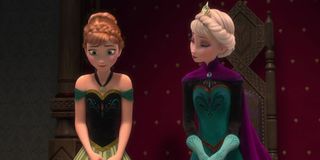12 Hot Facts We Learned During The Story Of Frozen Special

Frozen’s popularity is quite the phenomenon. In ABC’s brand new special geared to fans of the Disney movie, The Story of Frozen: Making a Disney Animated Classic, the cast and crew all join up to discuss the behind-the-scenes stories surrounding the making of the film, as well as try to come to grips with why Frozen has become as popular as it is. The hour-long event program is an exceptional special that probably should have been included on the disc as a bonus feature, but is still worth a watch in its current amalgamation, especially if you have family members who still love to belt out the lyrics to “Let it Go.”
If you weren’t plopped down in front of the television when The Story of Frozen aired on ABC this evening, we’ve put together a list of some of the hottest facts from the special that should help you to look like a Frozen expert in front of your kids. From Elsa's initial status as a villain to fun facts about Olaf, this list is a must-read. If you'd like to skip ahead to learn about the animated short the franchise is planning, we are cool with that, too.

Josh Gad is not really a snowman. In a funny joke at the beginning of the special, Gad laughs about the resemblance between himself and the animated snowman he plays in Frozen. Just to remind you, in real life he is not in danger of melting in the California sun.

Frozen almost didn’t get made. It took nearly seventy years to go into production. Walt Disney actually considered doing an animated version of “The Snow Queen” as early as 1937, but Disney was notorious for thinking about projects that took years to come to fruition. When John Lasseter took the reigns, he wanted to bring back “sincere” princess stories and Frozen eventually landed on the list.

The animators found inspiration for the younger versions of Anna and Elsa from their own children. Lots of awkward family photos were used during the making of this film. One animator even used his kid as inspiration for the snowman, Olaf. Apparently, his kid hops around a lot.

Idina Menzel was responsible for getting Elsa to look like a real singer on the big screener. At her suggestion, the animators included her breathing from her diaphragm to make the “Let it Go” scene seem more real. It helped the singer and actress to really fit with her character, as well.

The same animator with the kid who looks like a Snowman is related to Donny Osmond. So, that animator included a tribute to his Uncle’s lower body thrusts on big notes during the “Love is an Open Door” scene. Now, we are all privy to that family joke. If you have nightmares about his epic dance moves, don't blame me for it!
CINEMABLEND NEWSLETTER
Your Daily Blend of Entertainment News

John Lasseter does a wicked Olaf impression. For an idea of what that looks like, go no further than the scene where Kristoff introduces Anna to his Rock Troll family. Lasseter came up with Olaf talking to the side and whispering to Anna about Kristoff being a pretty strange dude.

Anna and Elsa weren’t initially conceived as sisters. Anna was going to be a peasant who comes to the castle in Arendelle in order to ask the Ice Queen to freeze her broken heart. Eventually, someone said, “What if they were sisters?” and Frozen's main bond was born.

“Do You Wanna Build A Snowman?” almost didn’t make the Frozen movie. As close to release as February of 2013, the song kept getting taken out, but those close to the movie sent emails and begged for it to be included in the final version of the movie. Apparently, this worked out well for everyone but the moms who have had to listen to it a thousand times in their minivans.

Rosemaling is everywhere in Norway and, subsequently, everywhere in Frozen. The rosemaling in the costumes of the characters is very beautiful, but the rosemaling element was used in a variety of ways, including in the ice when Elsa creates her beautiful ice castle. It's a great way to tie the design elements of the film together.

The writers wanted the snow to become a real character. They traipsed up to Wyoming where they played in the snow for two days to understand how snow could move and shape the setting, as well as be used in a playful manner in the movie, as when snow from a tree is dumped on to Anna’s head.

It took nine months to complete the scene where Elsa builds the giant snow castle in the shape of a snowflake. The castle as a snowflake with sharp points that expand is another idea that came from Lasseter, whose creative footprint is all over the film.

“Let it Go” was conceived when Elsa was still seen as a villain by the production company. Composers Robert Lopez and Kristen Anderson-Lopez were still able to find a sympathetic viewpoint with the song. Their song “fundamentally changed” the entire movie.

Jessica Rawden is Managing Editor at CinemaBlend. She’s been kicking out news stories since 2007 and joined the full-time staff in 2014. She oversees news content, hiring and training for the site, and her areas of expertise include theme parks, rom-coms, Hallmark (particularly Christmas movie season), reality TV, celebrity interviews and primetime. She loves a good animated movie. Jessica has a Masters in Library Science degree from Indiana University, and used to be found behind a reference desk most definitely not shushing people. She now uses those skills in researching and tracking down information in very different ways.
Most Popular








